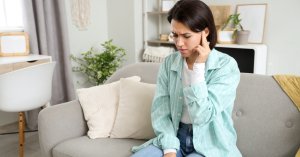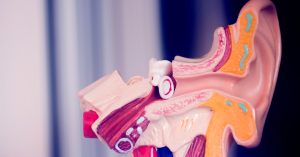Noise-canceling headphones have become a staple for commuters, travelers, office workers, and even people seeking a quiet moment at home. Their ability to drown out the hum of engines, chatter, or other distractions is undeniably appealing. But beyond the comfort and convenience they offer, an important question often arises: Can noise-canceling headphones actually protect your hearing?
This question is especially relevant for adults over 50 and those already experiencing some degree of hearing loss. As hearing health becomes a more prominent concern with age, people are increasingly looking for ways to prevent further damage. With so much noise in our everyday environments — from traffic to crowded restaurants — it’s natural to wonder if technology like noise-canceling headphones could offer more than just a better listening experience.
In this article, we’ll explore the science behind how these headphones work, the risks of noise-induced hearing loss, and whether using them could be a smart move for your long-term hearing health. Whether you’re a caregiver looking out for a loved one or simply someone curious about the safety of your audio gear, you’ll find practical insights and guidance ahead.
How Noise-Induced Hearing Loss Happens
Noise-induced hearing loss (NIHL) is one of the most common — and preventable — types of hearing damage. It occurs when the sensitive structures in the inner ear, particularly the hair cells in the cochlea, are damaged by excessive sound exposure. Unlike other types of hearing loss that can develop due to aging or illness, NIHL is directly linked to the environment, often caused by repeated or prolonged exposure to loud sounds.
The key factors that influence NIHL are sound intensity (measured in decibels, or dB) and exposure duration. Sounds above 85 dB can begin to cause hearing damage over time. For reference, busy city traffic registers around 85 dB, while concerts and power tools can exceed 100 dB. The louder the sound, the shorter the amount of time it takes for damage to occur. For example, exposure to 100 dB may start causing damage in as little as 15 minutes without hearing protection.
What makes NIHL especially concerning is that it often occurs gradually. Many people don’t realize their hearing is deteriorating until it’s too late. Early signs might include a constant ringing in the ears (tinnitus), difficulty understanding conversations in noisy places, or the need to turn up the volume on electronic devices.
Once those delicate inner ear structures are damaged, the effects are typically permanent. Unlike other parts of the body, the sensory hair cells in the inner ear do not regenerate. This makes prevention the most effective strategy — avoiding harmful sound levels and minimizing exposure whenever possible.
This is where noise canceling headphones come into the conversation. While they don’t “fix” existing hearing loss, they may play a role in helping to prevent further damage by reducing the need to blast audio in noisy environments — a behavior that many people adopt unconsciously just to hear clearly over background noise.
What Are Noise Canceling Headphones and How Do They Work?
Noise canceling headphones are designed to reduce unwanted ambient sounds, allowing users to enjoy audio at lower, safer volumes or simply experience a quieter environment. To understand how they might help protect hearing, it’s essential to know how these devices work. There are two primary types of noise cancelation: passive and active.
Passive noise canceling (also known as noise isolation) refers to the physical design of the headphones. Over-ear models with cushioned ear cups, for example, naturally block out some external sounds by creating a seal around the ears. This works similarly to wearing earplugs and is particularly effective at dampening higher-frequency sounds like voices or clattering dishes.
Active noise canceling (ANC) is where the technology really steps in. ANC headphones use built-in microphones to detect ambient noise in the environment — such as the roar of a plane engine or the hum of an air conditioner. Once detected, the headphones generate a sound wave that is the exact opposite (or “anti-phase”) of the incoming noise. When these two waves collide, they cancel each other out, significantly reducing the perceived volume of the background noise.
The result? A much quieter listening environment without needing to crank up the volume. This is particularly beneficial in consistently loud settings like airplanes, trains, or busy offices where people might otherwise turn up their audio dangerously high just to hear it over the surrounding noise.
It’s important to note that ANC works best on low-frequency, steady sounds — think engine rumbles or air conditioning units. It’s less effective at canceling sudden or high-pitched noises, such as conversations or car horns. That’s why many users benefit from a combination of passive and active noise canceling for the best results.
By minimizing background noise, noise canceling headphones allow listeners to enjoy music, podcasts, or calls at lower volumes, which could make them a useful tool in the fight against noise-induced hearing loss — especially when used thoughtfully.
Do Noise Canceling Headphones Actually Protect Hearing?
The short answer is: they can — but it depends on how you use them. Noise canceling headphones, particularly those with active noise cancelation (ANC), are not designed as medical hearing protection devices, but they can contribute to safer listening habits and potentially reduce the risk of noise-induced hearing loss.
One of the biggest advantages of noise canceling headphones is their ability to reduce ambient noise in loud environments. In settings like airplanes, subways, or busy cafés, people often turn up the volume on their headphones just to hear their music or podcast over the noise around them. This instinctive behavior can quickly push sound levels above safe thresholds — increasing the risk of hearing damage. ANC helps by reducing background noise, which means users can comfortably listen at lower volumes, often 10 to 20 decibels lower than they would without noise cancelation.
Studies support this. Research has shown that users of noise canceling headphones tend to set their volumes at significantly lower levels than those using standard headphones in noisy settings. This lower exposure to potentially harmful decibel levels can help prevent cumulative damage to the inner ear over time.
However, there’s a key distinction: noise canceling headphones don’t actively “protect” hearing in the way that earplugs or industrial hearing protection devices do. They aren’t blocking all sound, and they won’t prevent hearing loss if users are still blasting their audio at high volumes. The real benefit lies in their ability to create a quieter auditory environment, which encourages safer listening habits.
For people already experiencing mild hearing loss or tinnitus, noise canceling headphones can also provide relief by reducing environmental noise triggers and improving focus, especially in crowded or noisy places. Some users even report reduced stress or fatigue thanks to the quieter experience these headphones provide — another indirect benefit to overall auditory health.
In summary, noise canceling headphones can play a supportive role in protecting hearing — not by actively shielding the ears from all noise, but by encouraging lower volume listening and reducing unnecessary noise exposure in everyday environments.
Risks and Misconceptions About Noise Canceling Headphones
While noise canceling headphones can support healthier listening habits, there are several myths and misunderstandings about what they can and can’t do — and misusing them can actually negate their potential benefits. It’s important to separate fact from fiction to use these devices safely and effectively.
Myth 1: “Noise canceling headphones completely protect your ears from damage.”
This is a common misconception. Noise canceling headphones reduce ambient noise, but they don’t act as protective earplugs or industrial-grade hearing protection. They are designed to improve listening comfort, not to block out all dangerous sounds. Loud noises like sirens, construction equipment, or fireworks can still cause damage, even if you’re wearing ANC headphones.
Myth 2: “You can’t damage your hearing with noise canceling headphones.”
Even with noise cancelation enabled, listening to music or other audio at high volumes can still cause hearing loss. Many users mistakenly believe they can listen at any volume level without risk simply because outside noise is reduced. In reality, safe listening volume is still crucial — ideally under 85 dB, especially for prolonged sessions.
Myth 3: “All noise canceling headphones offer the same level of protection.”
Not all ANC headphones are created equal. Some lower-end models provide only modest noise reduction, especially in higher-frequency ranges. Others may offer misleading claims about noise cancelation capabilities. It’s worth investing in a well-reviewed pair that combines both active and passive noise canceling for the best effect, especially if you’re using them in particularly loud environments.
Additionally, there are a few risks associated with frequent headphone use in general:
- Overuse and ear fatigue: Wearing headphones for long periods can cause ear discomfort, pressure, or a sense of “ear fullness,” especially if they’re worn tightly or used continuously without breaks.
- Hygiene concerns: Extended headphone use can trap moisture and bacteria around the ears, especially with over-ear or in-ear styles. This may increase the risk of ear infections, particularly in warm or humid environments.
- Over-reliance on ANC: Some users become dependent on noise cancelation for everyday quiet, even in settings where it’s unnecessary. While this isn’t directly harmful, it can lead to reduced awareness of surroundings or discomfort when ANC is unavailable.
Ultimately, the key to maximizing the benefits of noise canceling headphones — and minimizing risks — is responsible use. Understanding their limitations and using them wisely makes a big difference in their impact on your long-term hearing health.
Tips for Safe Listening With Noise Canceling Headphones
Noise canceling headphones can be a valuable ally in protecting your hearing — but only if used correctly. Here are practical, evidence-based tips to help you get the most benefit from your headphones while minimizing potential risks.
1. Keep the Volume Low
One of the biggest advantages of noise canceling technology is that it allows you to enjoy audio at lower volumes, even in noisy environments. A good rule of thumb is the 60/60 rule: listen at no more than 60% of the maximum volume for no more than 60 minutes at a time. Modern smartphones and media players often include volume-limiting features or provide warnings when you’re listening at potentially harmful levels — take advantage of these tools.
2. Take Listening Breaks
Prolonged use of any headphones can strain your ears. To reduce the risk of fatigue or cumulative damage, take regular breaks — ideally a 5–10 minute break every hour. This gives your ears time to recover and reduces the likelihood of discomfort or overstimulation.
3. Choose Quality Headphones
Not all noise canceling headphones offer the same level of performance. Look for reputable brands that provide both active and passive noise cancelation, good ear cup design, and solid user reviews. Over-ear models generally provide better isolation and comfort, especially for older adults or those with sensitive ears.
4. Use Volume-Limiting Features
Many modern devices offer parental controls or volume limit settings. These can be especially helpful for caregivers managing devices for older adults with hearing concerns. If you use an iPhone or Android device, explore the health or accessibility settings to cap the maximum volume output.
5. Be Aware of Your Environment
While noise canceling headphones are excellent in controlled or predictable environments, using them in areas where awareness is critical — like walking near traffic — can be unsafe. Some models now include “transparency” modes that allow outside sounds in when needed, offering a balance between noise reduction and situational awareness.
6. Maintain Hygiene
Clean your headphones regularly, especially if you use them daily. Over-ear cushions and earbuds can trap sweat, oils, and bacteria, which may lead to irritation or infection. A quick wipe with a dry or slightly damp cloth (following the manufacturer’s guidelines) can keep them fresh and safe.
7. Avoid Sleeping with Headphones
Sleeping with noise canceling headphones on might seem like a good idea, especially for blocking snoring or environmental noise. However, it can lead to discomfort, pressure on the ears, or even tangling hazards if you’re using wired models. Instead, consider white noise machines or pillow speakers for safer sleep-friendly alternatives.
By following these tips, you can enjoy the benefits of noise canceling headphones while actively supporting your hearing health. Remember, it’s not just about the technology — it’s about how you use it.
Conclusion
Noise canceling headphones are more than just a luxury item — they can be a helpful tool in maintaining healthy hearing habits, especially in today’s noisy world. For adults over 50, caregivers, and anyone concerned about hearing loss, understanding how these devices work and how to use them properly is essential.
While they don’t provide the same level of protection as earplugs or industrial hearing protection, noise canceling headphones can significantly reduce your exposure to environmental noise. More importantly, they encourage users to keep volume levels at safer, more comfortable levels — one of the most effective ways to prevent noise-induced hearing loss.
That said, they’re not a one-size-fits-all solution. Misconceptions about their capabilities can lead to risky behaviors, such as listening at excessively high volumes or wearing them in unsafe situations. Like any tool, their effectiveness comes down to how they are used.
By staying informed and adopting a few simple best practices — such as keeping volumes in check, taking regular breaks, and investing in a high-quality pair — you can make the most of noise canceling headphones while protecting one of your most vital senses: your hearing.
Whether you’re navigating a busy city, enjoying a quiet moment on a flight, or just trying to focus in a crowded office, noise canceling headphones can enhance your experience and support your hearing health — when used wisely.
FAQ
Can noise canceling headphones prevent hearing loss?
Noise canceling headphones can help prevent hearing loss indirectly by reducing the need to turn up the volume in noisy environments. They lower background noise, allowing you to listen at safer levels. However, they do not block all harmful sounds and are not a substitute for proper hearing protection in extremely loud environments.
Are noise canceling headphones safe to use every day?
Yes, they are generally safe for daily use — as long as you follow safe listening practices. Keep the volume below 60% of the maximum, take regular breaks, and ensure the headphones fit comfortably to avoid ear fatigue or pressure.
Is it better to use over-ear or in-ear noise canceling headphones for hearing protection?
Over-ear headphones typically offer better passive noise isolation and are more comfortable for extended wear, especially for older adults. In-ear models can be effective too, but proper fit is crucial. Over-ear styles are generally preferred for reducing environmental noise more completely.
Can children or seniors safely use noise canceling headphones?
Yes, but with caution. For children and older adults, it’s important to use volume-limiting features and monitor usage. Caregivers should choose models with clear safety features and ensure that the volume remains at a safe level.
Do noise canceling headphones eliminate all background noise?
No, they are most effective at canceling out consistent, low-frequency sounds like engine noise or air conditioning hum. They are less effective at blocking sudden, high-pitched noises such as speech or alarms. Combining passive and active noise canceling features offers the best results.
“This article is for informational purposes only and is not a substitute for professional medical advice, diagnosis, or treatment. If you are concerned about your hearing or ear health, please consult a qualified healthcare provider.






